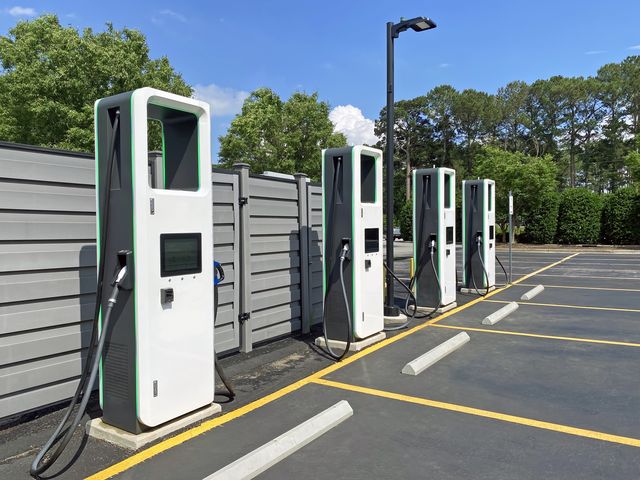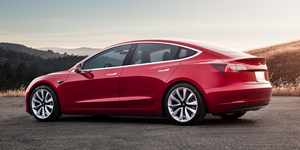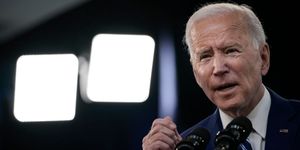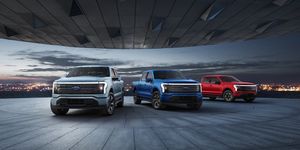- The $1 trillion infrastructure bill includes $7.5 billion for electric vehicle charging, which was slashed from $15 billion in negotiations.
- Considering that sum includes spending on other forms of propulsion infrastructure, the allocation will likely fall closer to to $5 billion.
- Some experts believe to accommodate a fully electrified vehicle fleet, at least $20 to $30 billion will have to be invested over the next 10 years.
There are a lot of big numbers being thrown about, but how much money is actually needed for public charging of electric vehicles? The critics don’t agree on the amount, but they’re mostly united in seeing the federal charging commitment to electrifying America as too small. Even worse, they say, the allocated money would have to be shared with refueling for hydrogen, propane, and natural gas.
The bipartisan $1 trillion infrastructure bill now includes an overall $7.5 billion for electric vehicle charging, which sounds like a lot before you realize it was slashed down from $15 billion in negotiations with Senate Republicans. And having to share with other forms of propulsion may get the allocation down to $5 billion. It’s not surprising that the cut met with howls of protest from activists who want to accelerate EV adoption.
“The current level of $5 billion for EV charging in the Senate infrastructure bill will not provide the charging network that the public needs to drive electric with confidence,” Joel Levin, executive director of advocacy group Plug In America, told Autoweek. “Imagine how comfortable you’d feel driving with gasoline if we took out two-thirds of the gas stations.” In July, there were 42,000 public charging stations in the US, with 5000 of them fast chargers, said the Department of Energy.
Jeff Davis, a senior fellow at the Eno Center for Transportation, has followed the money, and he says that the actual amount for EV charging is even less than $5 billion.
“First of all, $300 million is taken off the top for a joint DOT-Energy office to run all things EV, leaving $4.7 billion,” he told Autoweek. “And then another $75 million is taken for administrative expenses, leaving $4.625 billion. Another 10 percent of the remainder is reserved at the Secretary’s discretion for states that ‘require additional assistance to strategically deploy electric vehicle charging infrastructure.’ The remaining $4.155 billion is distributed by formula to the 50 states, Washington, DC, Puerto Rico, and the territories.”
According to that Federal Highway Administration formula, larger states are the big winners. Texas would get $407 million, California would get $383 million, Florida $198 million, New York $175 million, and Illinois $148 million. Vermont’s allocation is only $21 million, and Puerto Rico’s $13 million.
Plug In America says it supports Biden’s original $15 billion proposal, but Dan Zotos, spokesman for the newly formed Zero Emission Transportation Association, wants more. “To build sufficient charging stations to accommodate a fully electrified vehicle fleet, at least $20 to $30 billion will have to be invested over the next 10 years,” Zotos said. “And additional investments are required to expand consumer incentives for new and used light-, medium-, and heavy-duty EVs.”
The Electric Drive Transportation Association is a longtime advocate for EVs. It’s president, Genevieve Cullen, told Autoweek that it’s difficult to pin down an exact dollar figure to fully realize a national charging network, but she said the $7.5 billion is “a major amount of money,” and a good beginning. “Other federal money will be spent, and it will inspire additional private spending,” she said.
Analysts definitely want more chargers on the ground. The National Renewable Energy Lab (NREL) said in July that to meet California’s goal of at least five million light-duty EVs on California roads by 2030 would need up to 1.2 million chargers, beyond those located at single-family homes. According to Eric Wood, an NREL data science research engineer, “This represents a dramatic increase from the 70,000 public and shared private chargers operating in the state today.”
The Center for American Progress said in 2018 that the country will need 330,000 new public charging outlets by the end of 2025 to meet the original goals of the Paris climate accords.
Experts agree that more than 80 percent of EV charging will actually be done at home, mostly via Level 2 chargers. But public charging is still important, particularly in cities where apartment dwellers can’t just go to the garage and plug in. Further, urban enclaves such as Chicago have identified “charging deserts” in lower-income neighborhoods.
A huge boost to public charging was the $2 billion from the Volkswagen diesel settlement that went to fund Electrify America. The group is reportedly working to double (to 1800) the number of fast-charging stations in the US and Canada by 2025, and spend more than $2 billion. In July, Reuters reported that Volkswagen was looking to sell a stake in Electrify America. The company sought a co-investor “prepared to inject roughly $1 billion into the division,” Reuters said.
An August 9 letter from 28 Congress members to House and Senate leaders expressed “concern” about the funding level. “We must seize this once-in-a-generation opportunity to go big, go bold, and build the infrastructure that will take us in the 21st century,” it said. Their ask for the fully electric future: $85 billion.
Another group of House Democrats is targeting an even larger number: at least $160 billion for a wide range of incentives. In March President Biden himself called for total EV spending of $174 billion, which includes the $15 billion for charging. He envisions 500,000 charging stations across the country. As they say, good luck with that.
Do you think more federal money should be spent on building an EV charging infrastructure? Share your thoughts in the comments below.























